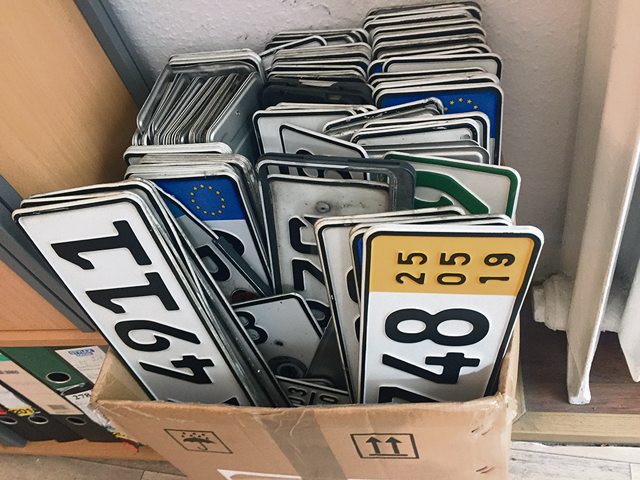
Germany has a very special method of issuing license plates depending on where you live. Unlike in the United States, where plates are issued according to states with different colors or designs. In Germany all plates are designed with black letters on a white background, they have a D (Deutschland) and the European Union symbol in a blue rectangle on the left.
Generally speaking, the larger a city, the shorter the abbreviation. For example, a car registered in Augsburg receives an A as the first letter, then a hyphen with one or two letters and a row of one to four digits.
It is also possible to register your car with a “wish plate” using a desired letter combination or your initials and a particular number you choose, such as a birthdate. A car registered as A-AB-123 could, but must not, be attributed to a person with the initials AB born on March 12.
The second set of combinations is for somewhat smaller cities, such as Kaiserslautern with KL, which is well familiar in the area. As some letters are already taken, it might be necessary to assign two letters for a large city, such as HH, which stands for Hansestadt Hamburg.
And, there are a few combinations used for special purposes, such as X for NATO vehicles or CD (Corps Diplomatique) for diplomats. Any plate with an E at the end, such as KL-EC-456E, means that this is an electric car. My personal favorite I spotted once was GI-NA 14!
Any smaller cities or even regions may be assigned a combination of three letters, an example of a town nearby is Homburg with HOM. There are also special combinations for official vehicles, such as NRW for police or leading politicians in Nordrhein-Westfalen.
Test your knowledge, or make it a challenge of finding out, how many plate combinations you know by taking our License Plate Quiz:
Level one: (1 point each, max. 10)
B – Berlin
M – M_________________
D – D_________________
E – E_________________
K – K_________________
L – L_________________
N – N_________________
P – P_________________
S – S_________________
Y – __________________
Your score:__________/10
Level two (2 points each)
MZ – M_________________
TR – T__________________
WI – W_________________
DD – D__________________
HB – H__________________ B___________________
FF – F__________________ /O___________________
FL – F__________________
NW – N__________________ / W__________________
ZW – Z__________________
IF – I__________________ F____________________
Your score:__________/20
Level three (3 points each)
GER – G__________________
DÜW – Bad D_______________ / W__________________
HRO – H__________________ R___________________
KUS – K__________________
BIT – B__________________
BIR – B__________________
KIB – K__________________
ROK – R__________________
SAB – S__________________
RLP – R__________________/ P___________________
Your score:__________/30
Your total score: __________/60
52 – 60 Points: Congratulations! You are very familiar with German plates and may frequently travel. Try to figure out all 700 different combinations!
35 – 51 Points: Well done! You may see a number of combinations on the roads in or near your area. Try to spot a few new ones and check them out once you are home.
1 – 34 Points: New things are inspiring! You are probably new to Germany and just getting accustomed to the plates and locations that go along with them. Use unfamiliar combinations as inspiration to discover sites and interesting places at your home away from home.
If you’re curious, visit: https://www.kennzeichenking.de/kfz-kennzeichen-liste
Answer key:
Berlin, München (Munich), Düsseldorf, Essen, Köln (Cologne), Leipzig, Nürnberg, Potsdam, Stuttgart, Y – Bundeswehr (German Armed Forces, special purpose)
Mainz, Trier, Wiesbaden, Dresden, Hansestadt Bremen, Frankfurt/Oder, Flensburg, Neustadt/Weinstrasse, Zweibrücken, IF – International Forces (U.S. military police, special purpose)
Germersheim, Dürkheim/Weinstrasse, Hansestadt Rostock, Kusel, Bitburg, Birkenfeld, Kirchheimbolanden, Rockenhausen, Saarburg, RLP – Rheinland-Pfalz (police and/or politicians, special purpose)


